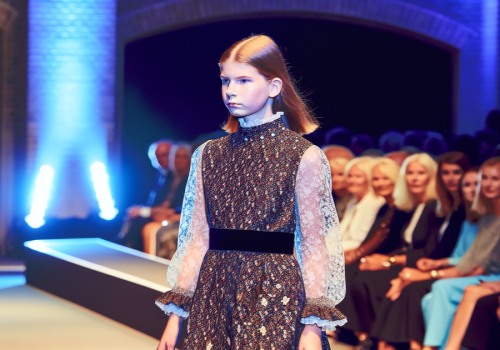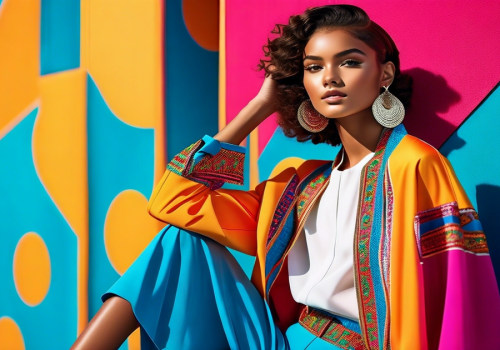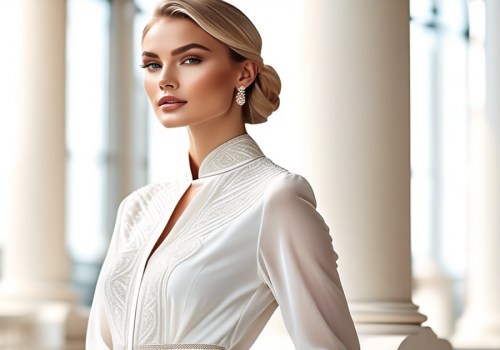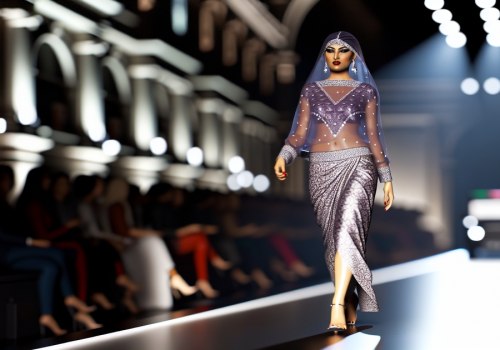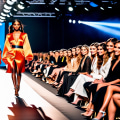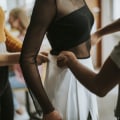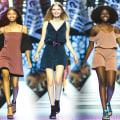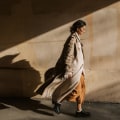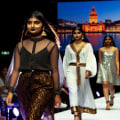Female fashion models - they epitomize elegance, grace, and style. But behind the glamour lies a world of hard work, dedication, and fierce competition. From the catwalk to high-fashion editorials, these women captivate audiences with their poise and charisma while challenging societal beauty standards.
We'll explore the demanding yet exhilarating life of a fashion model – from casting calls to runway shows – shedding light on both the glitz and the grind. Unveiling the secrets behind those flawless poses and enigmatic smiles, we'll uncover what it truly takes to thrive in an industry known for its cutthroat nature. So grab your front-row seat as we unravel the allure and challenges of being a female fashion model.
Fashion Landscape
Model Spotlight
Fashion models, especially female ones, play a pivotal role in the fashion industry. They are the face of major brands and designers, influencing trends and representing diverse beauty standards.
Female fashion models have evolved over time, from being predominantly tall and slender to now embracing diversity in body shapes, sizes, and ethnicities. This evolution reflects a positive shift towards inclusivity within the fashion industry.
The impact of social media on fashion is undeniable. Female models leverage platforms like Instagram to showcase their unique style and personality, gaining significant influence as trendsetters. Social media has also opened doors for aspiring models to gain exposure without traditional agency representation.
Evolution of Fashion Industry Trends
The global fashion market continues to expand rapidly with increasing demand for sustainable and ethical practices. Female models are at the forefront of this movement by advocating for eco-friendly fashion choices and promoting brands that align with their values.
Influential cities such as Paris, Milan, London, and New York hold considerable sway over international fashion, setting trends that resonate across continents. These global fashion capitals serve as hubs for female modelling careers due to their renowned fashion weeks and prestigious agencies.
Career Pathways
A notable example is Gigi Hadid's journey from aspiring model to international sensation. Her versatility on runways around the world showcases her adaptability while maintaining her distinctive look - an inspiration for many aspiring female models.
The achievements of Tyra Banks in breaking barriers as a black supermodel paved the way for greater diversity within the industry. Her success not only redefined beauty standards but also established her as a respected businesswoman through ventures like "America's Next Top Model."
Renowned model Kate Moss revolutionised 90s' grunge chic with her effortless style - embodying rebellion yet elegance - leaving an indelible mark on high-fashion editorials while navigating personal challenges publicly.
Defining Female Models
Various Routes to Becoming a Fashion Model
Becoming a fashion model can be pursued through various routes, such as signing with a reputable modelling agency or being scouted by talent scouts at fashion events. Many aspiring models also participate in casting calls and go-sees to showcase their potential to industry professionals. Some individuals gain recognition through social media platforms, using them as a launchpad for their modelling careers.
Transitioning from Amateur to Professional Modelling Transitioning from an amateur to professional model often involves building a strong portfolio that showcases versatility and the ability to embody different styles and looks. Aspiring models may start by collaborating with emerging photographers, makeup artists, and stylists to create diverse content that demonstrates their range in front of the camera.
Diverse Career Options Within the Modelling Industry The world of female modeling offers diverse career options beyond walking the runway or appearing in fashion campaigns. Models may explore opportunities in commercial modelling for products like cosmetics or clothing lines, delve into fitness or wellness endorsements, venture into acting or hosting roles, and even establish themselves as influential figures within the fashion community through blogging or vlogging about style trends and lifestyle choices.
Role Models
Legendary Female Figures in the Fashion World Throughout history, several legendary female figures have left an indelible mark on the fashion industry, shaping trends and redefining beauty standards. From Twiggy's iconic pixie cut defining 1960s mod culture to Naomi Campbell breaking barriers as one of the first black supermodels of her time—these pioneering women have significantly impacted how society perceives beauty and style.
Their Contributions to Shaping Fashion Trends These trailblazing women have contributed immensely towards shaping contemporary fashion trends by fearlessly challenging conventions. For instance, Kate Moss' waifish look revolutionized perceptions of ideal body types while Tyra Banks' groundbreaking achievements paved the way for inclusivity on runways worldwide.
Iconic Moments and Styles of Renowned Fashion Figures Renowned figures like Cindy Crawford showcasing denim cutoffs during her Pepsi commercial epitomize moments where these icons transcended traditional modelling roles. Their influence extended far beyond catwalks; they became cultural phenomena whose styles were emulated globally.
Industry Standards
Female Models Inspiring Positive Change in Society Many influential female models are leveraging their platforms not only for personal success but also for advocating positive change within society. They champion causes such as diversity on runways representing various ethnicities and body shapes authentically—a stark contrast from conventional beauty standards prevalent decades ago. Advocacy for Diversity, Body Positivity, or Mental Health Awareness Influential models advocate tirelessly for diversity across all facets of fashion—from casting choices reflecting real-world demographics to promoting body positivity initiatives empowering individuals irrespective of size or shape. Moreover, they spearhead mental health awareness campaigns aimed at destigmatizing issues prevalent within high-pressure industries like modelling. Empowering Messages and Actions ny Influential Models Empowering messages conveyed by influential female models resonate deeply with aspiring talents who find solace knowing that success is attainable without compromising individuality. Positive Impact on Aspiring Models and Fans Aspiring models draw inspiration from these influential figures who've shattered stereotypes while fans find comfort knowing that self-acceptance is pivotal amidst societal pressures regarding appearance norms.
Female Runway Models of 2023
Fashion models, especially female fashion models, are expected to uphold professional conduct and ethics within the modelling industry. This includes maintaining a positive attitude, being punctual, and treating everyone with respect. standard requirements for model measurements and appearance play a crucial role in this industry. Models are often required to meet specific height and size criteria, ensuring uniformity on the runway.
Furthermore, there are strict industry regulations and guidelines in place to safeguard the well-being of models. These cover aspects such as working hours, appropriate changing facilities at fashion shows or photoshoots, and protection from harassment or discrimination. Adhering to ethical practices is vital for female fashion models as they navigate their careers in this competitive field.
Female fashion models who exemplify these qualities have been making waves in the industry as emerging talents gain recognition. Their noteworthy achievements include gracing prestigious magazine covers, walking for renowned designers during Fashion Week events worldwide, and securing lucrative contracts with top-tier brands.
Types of Female Models
Runway Specialists
Fashion female models are integral to the success of renowned fashion brands. They collaborate with high-profile designers and labels, participating in promotional activities and campaigns as brand ambassadors. These collaborations significantly impact a model's career by elevating their visibility, credibility, and desirability within the industry.
Runway specialists are experts in showcasing designer collections on the runway. They master various runway techniques and styles, leaving a lasting impression with their notable appearances at prestigious fashion events. Their influence extends beyond individual performances; it shapes runway trends and presentations, setting the tone for upcoming seasons.
The partnerships between female models and fashion brands have far-reaching implications. Not only do they contribute to the commercial success of these brands, but they also enhance a model's portfolio and marketability. As brand ambassadors, female models become synonymous with luxury, elegance, or innovation - characteristics that resonate deeply with consumers.
Commercial Faces
In contrast to runway specialists' focus on haute couture presentations, commercial faces excel in promoting products through print media or digital platforms. Female models in this category make significant strides in commercial advertising by featuring prominently in print ads, digital campaigns, or television commercials.
Their success stories often revolve around their ability to adapt effortlessly to diverse products and services while maintaining an authentic connection with audiences. This versatility is instrumental in shaping consumer perception towards different brands or offerings across industries such as beauty products, lifestyle goods or technology gadgets.
Moreover, female commercial faces wield considerable influence over popular culture through their endorsements and representation of various lifestyle choices. By leveraging their unique appeal across different demographics, female models play a pivotal role in steering consumer preferences while reflecting evolving societal norms.
Plus-Size Pioneers
The rise of plus-size pioneers marks a significant shift towards inclusivity within the fashion industry. Female models excelling in this domain challenge traditional beauty standards by advocating for greater representation across all facets of fashion - from editorial spreads to catwalks.
Their success stories extend beyond conventional modelling avenues into realms such as body positivity movements where they champion self-acceptance regardless of size or shape. By breaking barriers previously imposed by narrow beauty ideals, female plus-size pioneers pave the way for greater diversity within mainstream fashion narratives while empowering individuals to embrace their bodies unapologetically.
Petite Figures
Leading female figures who defy conventional height expectations continue to challenge established norms within the modelling industry. These trailblazers advocate relentlessly for inclusivity, redefining what constitutes an ideal physique. They have achieved remarkable milestones, serving as beacons of inspiration for aspiring models seeking validation outside traditional beauty benchmarks. Their influence transcends mere aesthetics, it fosters empowerment among individuals striving for acceptance irrespective of physical attributes. By expanding representations, female petite figures propel forward conversations surrounding body positivity, resonating profoundly with audiences navigating complex societal pressures regarding appearance standards.
The Evolution of Female Modelling
Decades of Change
The world of fashion modelling has witnessed significant evolution over the decades, with a notable shift towards embracing diverse body types and representations. Successful careers of petite female models have challenged traditional standards, proving that height is not the sole determinant of success in the industry. For instance, models like Devon Aoki and Kate Moss have achieved remarkable success despite not fitting into the conventional tall model archetype.
Niche opportunities for petite models in fashion have emerged as designers and brands recognise the value of inclusivity. This shift has opened doors for petite female models to showcase their unique beauty and style on runways, magazine covers, and advertising campaigns. As a result, petite women are now able to pursue thriving careers in an industry that once seemed exclusive to taller individuals.
Representation of diverse body types in the industry has played a crucial role in redefining beauty standards. By featuring models with varying heights, sizes, and proportions across fashion campaigns and editorials, the industry has taken strides towards promoting body positivity and self-acceptance among women.
Diversity Inclusion
The evolution of female beauty ideals over different eras reflects society's changing perceptions of attractiveness. From Marilyn Monroe's voluptuous figure to Twiggy's slender frame during the 1960s, these shifting trends in women's fashion have influenced modelling standards significantly. Each era brought forth its own set of iconic figures who embodied the prevailing beauty ideal at that time.
Historical milestones for women in the modelling industry mark pivotal moments where societal changes were mirrored through fashion. The rise of supermodels such as Naomi Campbell and Tyra Banks signified a departure from Eurocentric beauty norms while paving the way for greater diversity within mainstream media representation.
Reflections on societal changes through fashion highlight how shifts in cultural attitudes towards race, gender identity, and individuality are often echoed within popular culture phenomena like runway shows or editorial spreads.
Digital Influence
In today's digital age, there is an increasing promotion of diversity among female models across various online platforms such as social media channels and e-commerce websites. Advancements towards inclusive representation in fashion are evident through initiatives aimed at celebrating ethnicities from around the world while dismantling stereotypes associated with specific racial or cultural groups.
Initiatives supporting ethnic, racial, and cultural diversity aim to create opportunities for underrepresented communities within the modelling sphere by fostering an environment where individuals from all backgrounds can thrive equally without facing discrimination based on their appearance or heritage.
The impact of diverse casting choices on the industry cannot be understated; it goes beyond mere aesthetics by shaping perceptions about inclusivity both within the industry itself as well as among consumers worldwide.
The Supermodel Era
'90s Icons
The '90s era introduced a new breed of fashion models, catapulting them to global stardom. Iconic figures like Cindy Crawford, Naomi Campbell, and Kate Moss became synonymous with the term "supermodel." Their influence extended beyond traditional modelling avenues, as they ventured into acting, business ventures, and philanthropy.
These female models were not only celebrated for their striking looks but also for their charisma and larger-than-life personalities. They graced countless magazine covers, walked prestigious runways, and starred in groundbreaking advertising campaigns. Their impact on pop culture was undeniable; they set beauty standards and shaped fashion trends that continue to resonate today.
Despite the absence of digital platforms during their prime years, these '90s icons remain relevant in the age of social media. Their enduring appeal is evident through collaborations with contemporary brands and designers who seek to harness the nostalgia associated with this iconic era.
Utilisation of Digital Platforms by Female Models
In today's digital landscape, female models leverage various online platforms to amplify their presence and reach a wider audience. Through Instagram, Twitter, YouTube channels or personal blogs**, these models share glimpses into their daily lives while promoting brands they endorse or products they believe in.
By engaging directly with fans through social media posts or live streams**, female models establish deeper connections that transcend traditional print or runway appearances. This direct interaction fosters brand loyalty among followers who are drawn not only to a model's physical appearance but also to her personality and lifestyle choices.
Social Media Impact on a Model's Career Trajectory
The advent of social media has redefined how female models navigate their careers. Unlike previous generations where success relied heavily on securing coveted magazine covers or high-profile runway shows**, modern-day supermodels can cultivate substantial followings independently from established institutions within the industry.
This shift allows aspiring female models greater control over their narratives**, empowering them to shape public perceptions without solely relying on external validation from agencies or publications. The democratization of fame facilitated by platforms such as Instagram has levelled the playing field for emerging talents seeking recognition outside traditional gatekeepers.
Influential Online Presence of Prominent Female Models
Prominent female models have harnessed social media as a tool for self-promotion by strategically curating content that showcases both professional achievements and personal endeavours. By providing behind-the-scenes access to photoshoots, exclusive events, travel diaries, fitness routines, skincare regimens and more, these influential figures offer an unfiltered glimpse into their multifaceted lifestyles.
Their ability to connect authentically with audiences transcends geographical boundaries and cultural differences. This accessibility has transformed them into relatable role-models whose influence extends far beyond conventional notions of beauty or glamour.
Leveraging Technology for Personal Branding
Female models recognise technology's pivotal role in cultivating distinctive personal brands. They capitalise on multimedia content creation - including vlogs, podcasts*, tutorials and interactive Q&A sessions-to engage followers meaningfully while reinforcing brand partnerships.
Moreover, leveraging Augmented Reality (AR) filters enables them to develop customised visual experiences that resonate deeply with fans. These innovative approaches underscore how female models embrace cutting-edge technologies to elevate storytelling capabilities whilst fostering authentic connections within virtual spaces
Becoming a Female Model
Becoming a fashion model is often perceived as an elusive dream, but the lasting influence left by legendary female models has paved various entry routes into the industry. These iconic figures have significantly contributed to shaping modern-day modelling standards, leaving an enduring impact on current generation models.
Legendary female models such as Twiggy, Naomi Campbell, and Kate Moss have played pivotal roles in defining beauty and fashion ideals. Their timeless contributions continue to be recognised and celebrated within the industry. By breaking barriers and redefining traditional standards of beauty, these trailblazers have opened doors for aspiring female models today.
Aspiring female models can now explore diverse pathways into the industry due to the influence of these iconic figures. From runway shows to high-fashion editorials, there are accessible entry points that allow newcomers to kick-start their careers. The recognition of diversity in body types and ethnicities owes much credit to the groundbreaking work of past female models who challenged conventional norms.
The endurance of their impact not only reflects a shift in societal perceptions but also highlights how they've helped shape modern-day modelling standards. Aspiring female models can draw inspiration from these influential figures while navigating challenges as new entrants into modelling.
Agency representation plays a crucial role in providing opportunities for aspiring female models looking to establish themselves within the competitive world of fashion. Reputable agencies offer essential support systems that guide emerging talents through their career trajectories.
For many aspiring female models, securing representation with established agencies marks a significant milestone in their journey towards success within the fashion industry. Agencies serve as intermediaries between clients and talent, facilitating professional connections that are vital for career growth.
Despite its significance, agency representation also comes with its own set of benefits and challenges for female models entering this domain. While it provides exposure to high-profile opportunities such as international runway shows and luxury brand campaigns, it also entails intense competition within agency rosters.
Navigating through this landscape requires resilience alongside adaptability; however, reputable agencies remain instrumental in propelling a model's success trajectory.
While agency representation holds undeniable importance for aspiring female fashion models seeking guidance throughout their careers, freelance opportunities present an alternative route within the industry's landscape. Freelancing allows more autonomy over one's career choices without being bound by exclusive contracts or agency regulations.
For some talented individuals aiming at becoming successful independent entities within this field may find freelance work more appealing than traditional agency representation due to its flexibility regarding project selection. However beneficial freelancing might seem at first glance; it does come with its own set of challenges including self-management responsibilities such as networking independently or managing finances without institutional support found when working under renowned agencies.
Skills for Success
Posing Techniques
Fashion models, particularly female ones, need to master a wide range of posing techniques to excel in their careers. They must be able to convey different emotions and attitudes through their poses, whether it's for a high-fashion editorial shoot or a commercial campaign. This requires the ability to understand and interpret the photographer's vision while also bringing their own unique flair to each pose.
For freelance female models, exploring avenues outside traditional agency representation can be both liberating and challenging. While being independent allows them more control over their careers and creative direction, they may face difficulties in finding consistent work without the support of an agency. However, with determination and strategic networking efforts, many freelance female models have carved out successful careers by leveraging social media platforms and building strong personal brands.
Challenges faced by freelance female models include navigating client negotiations independently, managing finances effectively without an agency's support, and dealing with potential isolation from industry connections that agencies often provide. Despite these obstacles, numerous success stories exist within the realm of independent female modelling where individuals have established thriving careers on their own terms through dedication and perseverance.
Runway Walks
Mastery of posing skills is crucial for all successful fashion models; this is especially true for females who are expected to exude confidence and elegance on the runway. Different posing styles suit various types of shoots – from avant-garde editorials to commercial catalogues – so versatility is key.
The influence of posing techniques on visual storytelling cannot be overstated; every angle or curve communicates something specific about a garment or accessory being showcased. A model’s ability to embody the essence of a brand's vision through her poses contributes significantly towards creating compelling narratives within fashion photography or videography.
Posing coaches play an essential role in enhancing a model’s skills by providing personalised guidance on posture refinement, expression modulation, body language interpretation etc., which collectively contribute towards elevating her overall performance during shoots.
Brand Alignment
Mastering runway walks is not just about strutting down catwalks but also aligning oneself with diverse walking styles that resonate with different fashion brands' aesthetics. Successful runway models possess the adaptability required to embody various brand personas seamlessly through their walk – from ethereal gracefulness at haute couture shows to confident power-walking at sportswear presentations.
Training methods aimed at perfecting a model’s runway walk encompass rigorous practice sessions focusing on gait precision, poise maintenance under pressure situations such as live shows or casting calls etc., thereby instilling confidence in her walk that translates into impactful stage presence.
Health and Lifestyle
Fitness Regimes
Maintaining a healthy and fit physique is crucial for female fashion models. They need to align with compatible brands that value health, fitness, and overall well-being. By partnering with brands that promote these values, female models can enhance their image and appeal to a wider audience. For instance, if a model endorses a sportswear brand known for its focus on fitness, it can positively influence the public's perception of her commitment to leading an active lifestyle.
Factors such as the brand's target demographic, core values, and marketing strategies play a pivotal role in determining suitable brand-model partnerships. Female models must consider how their personal fitness regimes align with these factors before committing to any brand collaboration. The synergy between the model’s fitness routine and the ethos of the brand should be seamless.
Building strong connections with brands is essential for female models seeking long-term success in the industry. These connections not only provide regular work but also contribute to building credibility within the fashion world. By consistently associating themselves with reputable brands that share their dedication to health and fitness, female models establish themselves as authoritative figures in promoting wellness through fashion.
The impact of brand alignment on a model's image cannot be overstated. When consumers see female models advocating for health-conscious brands or products, they are more likely to perceive them as role models who embody an aspirational lifestyle centred around staying fit and healthy.
Nutrition Plans
Embracing fitness as an essential aspect of being a successful female fashion model, nutrition plays an equally vital role in maintaining overall well-being while meeting industry standards for physical appearance. Tailored nutrition plans complement workout routines designed specifically for sustaining a model’s physique without compromising her health.
Balancing fitness goals with overall well-being is paramount for female models striving towards sustainable success in their careers. Nutrition plans tailored specifically for them ensure that they meet industry demands while prioritising their physical health over unrealistic body standards often associated with modeling.
Influence from rigorous fitness regimes extends beyond just physical changes; it significantly impacts mental well-being too by boosting confidence levels among female fashion models. A balanced diet contributes not only to maintaining optimal weight but also enhances mood stability through proper nourishment.
Mental Wellbeing
Following balanced nutrition plans forms an integral part of every successful female fashion model’s lifestyle choice since it directly influences energy levels necessary for enduring demanding schedules during photoshoots or runway shows. Nutritional considerations specific to female modelling requirements include ensuring adequate intake of nutrients essential for hair strength (e.g., protein), skin radiance (e.g., vitamins A & E), nail durability (e.g., biotin), etc. Maintaining healthy eating habits while pursuing modelling careers is imperative since poor dietary choices could adversely affect both physical appearance and mental acuity—critical elements influencing casting decisions made by top designers or agencies.
The Business of Modelling
Prioritising mental health amidst the demands is crucial. The pressure to maintain a certain look and meet industry standards can take a toll on mental wellness. Aspiring or established models often face stress, anxiety, and body image issues due to the competitive nature of the industry.
Female models must employ coping strategies to manage stress effectively within the modelling profession. This may involve seeking support from mental health professionals, engaging in self-care practices such as meditation and exercise, and building a strong support network among fellow models. By sharing experiences and promoting open discussions about mental wellness, aspiring or established female models can create a supportive community that fosters positive mental health.
Successful negotiation tactics employed by experienced female models play an essential role in promoting mental wellness within the modelling community. By advocating for reasonable working hours, fair treatment, and consideration for their overall well-being during contract discussions with agencies and clients, they set a precedent for healthier work environments within the industry.
Brand Partnerships
Navigating brand partnerships as professional female models involves understanding legal aspects involved in modeling contracts. Female fashion models need to be aware of their rights regarding image usage, exclusivity clauses, payment terms, and potential conflicts of interest when entering into brand partnerships.
Challenges faced during contract discussions within the industry often revolve around ensuring that all parties are satisfied with the terms while protecting individual interests. Experienced female models leverage their knowledge of contractual obligations to negotiate favourable terms that align with their career goals while maintaining professional relationships with brands.
Financial Management
Collaborative ventures between brands and influential female fashion models require effective strategies for financial management. Successful model-brand partnerships are built on clear communication regarding expectations, deliverables, compensation structures, and long-term objectives.
Strategies employed by successful female fashion models when partnering with brands include conducting thorough research on potential partners' values alignment with personal brand identity before committing to collaborations. They also focus on creating mutually beneficial outcomes through authentic storytelling that resonates with target audiences while elevating brand visibility.
Impactful brand ambassadorships led by prominent female figures have paved new avenues for financial empowerment within the modelling industry. By leveraging their influence across social media platforms alongside traditional marketing channels like print media or runway shows, female fashion models have redefined what it means to be both influential endorsers of products/services whilst being financially prudent individuals who understand how best they can use this platform not only enhance themselves but others too.
Navigating Challenges
Industry Pressures
Female fashion models often face unique challenges in managing their finances due to the irregular nature of their income. It's crucial for them to develop effective budgeting strategies tailored to accommodate fluctuating earnings. This might involve setting aside a portion of each paycheck for essential expenses and creating an emergency fund for unforeseen circumstances.
Investment considerations specific to modeling careers should also be taken into account. For instance, allocating funds towards professional development, such as attending workshops or hiring a career coach, can help female models enhance their skills and expand their opportunities within the industry.
Navigating financial stability within the dynamic modelling industry requires adaptability and foresight. Models may experience periods of high demand followed by quieter spells, so it's essential to plan for these fluctuations by building a robust financial safety net.
Future of Female Modelling
Technological Advancements
The fashion industry has witnessed a remarkable transformation due to technological advancements. With the rise of social media and digital platforms, female models now have greater opportunities to showcase their talent and connect with a global audience. Platforms like Instagram, TikTok, and YouTube have become powerful tools for aspiring models to gain visibility and build their personal brand. The use of virtual reality (VR) and augmented reality (AR) has also revolutionized the way fashion shows are conducted, providing an immersive experience for both models and audiences.
Moreover, the advancement in 3D scanning technology has enabled designers to create custom-fit clothing that perfectly complements the diverse body types of female models. This not only promotes inclusivity but also empowers women to embrace their unique features without conforming to traditional beauty standards. Artificial intelligence (AI) is being utilised by modelling agencies to streamline the selection process by analysing vast amounts of data to identify potential talents based on specific criteria such as facial symmetry or body proportions.
Furthermore, technological innovations have paved the way for remote photoshoots and digital collaborations between female models and fashion brands across different geographical locations. This has opened up new avenues for international exposure while reducing travel-related carbon footprint associated with traditional photoshoots.
Sustainable Practices
The future of female modelling is intricately linked with sustainable practices that prioritise environmental conservation and ethical production processes. Many fashion brands are embracing eco-friendly materials such as organic cotton, recycled polyester, or innovative fabrics derived from plant-based sources like pineapple leaves or orange peels. These sustainable materials not only reduce reliance on non-renewable resources but also minimise environmental impact by promoting biodegradability.
There is a growing emphasis on adopting circular economy principles within the fashion industry where garments are designed for longevity through durability and timeless style rather than fast-paced trends leading to excessive consumption. Female models play a crucial role in advocating sustainability by endorsing ethical fashion brands that align with their values towards responsible consumption.
Furthermore, initiatives like slow fashion movements encourage consumers to invest in high-quality pieces rather than succumbing to impulse buying trends resulting in excessive waste generation. Female models can leverage their influence on social media platforms by educating their followers about conscious consumerism while promoting second-hand shopping or clothing rental services as viable alternatives contributing towards a more sustainable future for fashion.
Global Outreach
In today's interconnected world, female modelling transcends geographical boundaries through global outreach facilitated by digital platforms enabling collaboration between diverse cultures and communities worldwide. Social media serves as an influential tool allowing female models from various backgrounds to share their stories authentically while fostering inclusivity within the industry.
Moreover, international runway events provide female models with opportunities to represent cultural diversity on prestigious stages which contributes towards reshaping conventional beauty standards prevalent in mainstream media narratives. By participating in these global events alongside renowned designers from different countries, female models actively contribute towards creating representation that resonates with audiences globally.
Additionally, the emergence of online marketplaces enables female models to collaborate directly with international clientele and independent designers without intermediaries, expanding career prospects beyond local markets. This fosters cross-cultural exchange benefiting both the model community and designers seeking fresh perspectives inspired by diverse experiences.
By embracing technological advancements, adopting sustainable practices, and leveraging global outreach opportunities, female modeling is poised at an exciting juncture ushering in a transformative era shaping its vibrant future.
Closing Thoughts
So, there you have it - a glimpse into the dynamic world of female fashion modelling. From the evolution of female models to the skills required for success, we've covered it all. The future of female modelling looks promising, with a diverse range of talents shaping the industry. Whether you're aspiring to become a model or simply fascinated by this glamorous realm, remember that success in this field demands hard work, resilience, and a strong sense of self. Embrace your uniqueness and stay focused on your goals.
Now that you've delved into the intricacies of female modelling, why not take some time to reflect on how these insights can apply to your own journey? Whether it's pursuing a dream career or appreciating the artistry behind fashion, there's always something to learn from the experiences of others in this ever-evolving industry.
Frequently Asked Questions
What are the different types of female models?
There are various types of female models, including runway models, commercial models, plus-size models, fitness models, and glamour models. Each type has its own specific requirements and opportunities within the fashion industry.
How can someone become a successful female model?
Becoming a successful female model requires dedication, perseverance, professionalism, and a strong work ethic. It's essential to develop modelling skills, maintain physical health and fitness, build a professional portfolio, and network within the industry.
What skills are crucial for aspiring female models?
Critical skills for aspiring female models include confidence in front of the camera or on the runway, adaptability to diverse modelling assignments and environments, effective communication with photographers and clients, as well as strong time management abilities to juggle bookings and auditions.
What is the future outlook for female modelling?
The future of female modelling is evolving with greater diversity in body shapes and ethnicities being embraced by brands. The rise of social media influencers also presents new opportunities for aspiring female talents to establish their careers through digital platforms alongside traditional avenues like runway shows and photo shoots.
Who were some iconic supermodels from the '90s era?
The '90s era produced several iconic supermodels such as Cindy Crawford, Naomi Campbell, Claudia Schiffer, Kate Moss, and Linda Evangelista. These influential figures not only dominated runways but also became cultural icons synonymous with fashion excellence.
Female Fashion Models of 2024
The Role of Female Fashion Models
Female fashion models play a crucial role in the fashion industry, serving as the face of brands and designers. They showcase clothing, accessories, and beauty products through various mediums such as runway shows, print advertisements, social media campaigns, and more. Their ability to embody different styles and aesthetics helps create aspirational images for consumers.
Fashion models also contribute to setting trends by influencing what is considered stylish and fashionable. Their presence at high-profile events like fashion weeks can significantly impact the popularity of certain designs or even establish new fashion movements. In addition to their visual appeal, female fashion models often serve as ambassadors for inclusivity and diversity within the industry.
The influence of female fashion models extends beyond just modelling clothes; they are seen as cultural icons who represent beauty ideals that evolve over time. By embracing unique features and promoting body positivity, they challenge traditional standards of beauty while empowering individuals to embrace their own identities.
Evolving Standards in Female Fashion Modelling
The landscape of female fashion modelling has been gradually shifting towards greater diversity and inclusivity. While traditionally there was a narrow definition of beauty in the industry, contemporary standards now celebrate a wider range of body types, ethnicities, ages, and gender expressions. This shift reflects an increased awareness around representation and authenticity.
In recent years, there has been a growing demand for more authentic representations in advertising campaigns featuring female fashion models. Brands are recognising the importance of showcasing real-life diversity to resonate with consumers on a deeper level. This trend has led to an increase in opportunities for models from diverse backgrounds who may not have fit into conventional beauty norms before.
Moreover, female fashion models are increasingly using their platforms to advocate for important social issues such as sustainability within the industry or mental health awareness. Many have become vocal about promoting environmentally friendly practices or speaking out against unrealistic beauty standards perpetuated by mainstream media.
The Future Outlook
As we look ahead to 2023, female fashion modelling is expected to continue its trajectory towards more inclusive representation across all aspects - from body types to racial diversity - reflecting a broader spectrum of real-world demographics. This evolution will likely lead to the continued celebration of individuality among female fashion models, inspiring confidence among people who haven't always seen themselves represented in mainstream media. Additionally, female fashion models will likely take on roles beyond modeling itself-venturing into entrepreneurship, becoming influential figures in various industries, and expanding their reach through digital platforms like social media and e-commerce.
Top Female Runway Models
Breaking Barriers
Female fashion models have been breaking barriers and redefining beauty standards on the runway. They are challenging traditional norms by embracing diversity in terms of body shapes, sizes, and ethnicities. This inclusivity has paved the way for a more representative and empowering fashion industry.
These models are not just faces; they embody confidence, strength, and individuality. Their presence resonates with women worldwide, inspiring them to embrace their unique qualities. By showcasing a diverse range of talents and looks, these female fashion models are creating a positive impact on society's perception of beauty.
Their influence extends beyond the runway as well. Many female fashion models use their platforms to advocate for social causes such as body positivity, mental health awareness, and gender equality. Through their actions both on and off the catwalk, they serve as role models for young girls aspiring to pursue careers in modelling or any other field.
Embracing Diversity
The rise of female fashion models from various cultural backgrounds has brought about an era of inclusivity in the fashion world. These talented individuals represent different countries, cultures, and traditions through their unique styles and personas.
For instance:
Naomi Campbell broke barriers as one of the first black supermodels to achieve global recognition.
Adut Akech has become an influential figure representing South Sudanese heritage.
Liu Wen made history as China's first supermodel to walk international runways extensively.
Their success stories highlight how diversity enriches the industry by celebrating different perspectives while dismantling stereotypes related to beauty standards.
Moreover:
Ashley Graham is renowned for promoting body positivity by challenging unrealistic beauty ideals.
Winnie Harlow's distinctive features have shattered conventional notions of skin conditions being obstacles in modelling careers.
These examples demonstrate that female fashion models play a pivotal role in reshaping societal perceptions regarding physical appearance.
Redefining Beauty Standards
Female fashion models are at the forefront of redefining conventional beauty standards prevalent within mainstream media. They challenge preconceived notions by embracing natural attributes such as freckles, scars, or unconventional features that were previously considered non-traditional.
By doing so:
They empower individuals who may feel underrepresented due to societal pressures dictating ideal appearances.
They inspire others to embrace their unique characteristics without conforming to unrealistic expectations set by commercial industries.
In essence:
The presence of diverse female fashion models encourages people from all walks of life to celebrate their individuality rather than striving for unattainable perfection dictated solely by external influences.
By championing diversity across various spectrums including race, ethnicity, and physical attributes, female fashion models continue influencing positive changes within society.
Supermodels of the '90s
Rise to Fame
Female fashion models in the 1990s experienced a meteoric rise to fame, becoming iconic figures in the industry. These supermodels were not just faces on magazine covers; they became household names and style icons. Their influence extended beyond the runway, shaping trends and redefining beauty standards.
The likes of Cindy Crawford, Naomi Campbell, and Kate Moss dominated catwalks and campaigns, captivating audiences with their unique looks and charisma. They represented a diverse range of ethnicities and body types, challenging traditional notions of beauty. The "Big Six" - consisting of Linda Evangelista, Christy Turlington, Claudia Schiffer alongside Crawford, Campbell, and Moss - epitomised the era's glamour.
Their impact wasn't limited to fashion; these women transcended into popular culture through music videos (such as George Michael's "Freedom! '90") and film appearances. Their larger-than-life personas made them more than just mannequins draped in designer clothes; they became symbols of empowerment for women worldwide.
Runway Revolution
The female fashion models of the '90s revolutionized the runway scene by injecting personality into their performances. They didn't merely walk; they commanded attention with their confidence and attitude. This marked a departure from earlier decades when models maintained an air of detachment on the catwalk.
Their presence transformed fashion shows into theatrical spectacles where each strut exuded power and allure. The supermodels' ability to embody a garment's essence elevated them from mere clothes hangers to storytellers within each collection they showcased.
Moreover, these iconic figures weren't confined by conventional standards - they embraced individuality unapologetically. Whether it was Evangelista's ever-changing hairstyles or Moss's waifish aesthetic that contrasted with curvier contemporaries like Crawford, diversity thrived during this era.
Their influence also extended beyond physical appearance; these women dictated trends that resonated globally - from slip dresses to bold red lipstick shades that defined an entire decade’s aesthetic.
Enduring Legacy
The legacy left behind by these fashion models female continues to shape contemporary perceptions of beauty in profound ways even today. Their impact can be seen in today’s modelling landscape where diversity is celebrated more than ever before – embracing different body shapes, ethnicities, and ages. These trailblazers set a precedent for inclusivity that paved the way for future generations seeking representation within fashion.
Types of Female Models
Runway Models
Runway models, also known as fashion models, showcase clothing and accessories during fashion shows. They are typically tall, slender, and possess striking features. These models need to exude confidence and grace while walking down the runway. Their primary role is to bring life to designer garments, capturing the attention of the audience and potential buyers.
Runway models have a distinct ability to embody the essence of high-end fashion brands such as Chanel, Gucci, or Prada. They must master various walking techniques like the classic runway walk or specific choreographed movements tailored for a particular show's theme. With their captivating presence on the catwalk, they play an instrumental role in influencing current trends and setting new standards in the fashion industry.
These models often work closely with renowned designers and stylists who meticulously curate their looks for each show. The intense competition among aspiring runway models necessitates maintaining exceptional physical fitness levels through regular exercise routines and balanced diets.
Editorial Models
Editorial models primarily feature in magazines, newspapers, online publications, or editorial shoots that aim to convey a specific narrative or concept through visual storytelling. Unlike commercial modeling which focuses on promoting products directly to consumers via advertisements; editorial modeling emphasises artistic expression by collaborating with photographers and creative teams.
Their versatility allows them to adapt effortlessly across different themes ranging from haute couture editorials in Vogue magazine to street-style-inspired spreads in Elle magazine. Editorial modelling requires strong emotive capabilities as these professionals often convey complex emotions or portray characters within their photoshoots.
The success of an editorial model depends on her capacity to interpret diverse concepts while maintaining authenticity throughout her portfolio of work. This type of modelling offers significant opportunities for exposure due to its association with reputable publications that command substantial readership worldwide.
Editorial models participate in elaborate photo shoots where they may be required to embody historical figures one day while showcasing avant-garde makeup trends another day — all contributing towards expanding their repertoire as versatile artists within the fashion industry.
Fit Models
Fit models serve as crucial assets for clothing manufacturers during product development stages by providing feedback on garment fit and comfort levels before mass production begins. These individuals act as live mannequins whose measurements precisely match standard sizing requirements across different apparel categories such as dresses, tops, bottoms etc.
They collaborate closely with design teams offering valuable insights regarding fabric drape quality alongside any necessary adjustments needed for improved wearability prior to finalizing patterns used for manufacturing purposes. Fit modelling demands consistent body measurements maintenance making it essential that these professionals sustain healthy lifestyles conducive towards preserving accurate proportions critical within this niche sector.
Becoming a Female Model
The Modelling Industry
The modelling industry is highly competitive and requires dedication, hard work, and resilience. Aspiring female models need to understand the different facets of the industry, including runway, commercial, plus-size, and editorial modelling. Each category has its own requirements and expectations.
Budding female models should be aware that the fashion world often sets unrealistic standards for beauty. It's essential to embrace individuality and uniqueness while also being open to constructive feedback from professionals in the field. Understanding one's body type and how it fits into various modelling categories is crucial for success.
It's important for aspiring female models to have a strong support system comprising family members or friends who can provide encouragement during challenging times. Seeking guidance from experienced mentors or agents can offer valuable insights into navigating the complexities of the industry.
Building Your Portfolio
Creating a diverse portfolio that showcases versatility is vital for female models looking to establish themselves in the industry. A well-curated portfolio should include a range of photographs highlighting different looks, styles, moods, and poses.
Collaborating with reputable photographers can help aspiring female models build their portfolios effectively. These professional photoshoots contribute significantly towards creating a polished image that resonates with potential clients and agencies.
In addition to high-quality images showcasing various styles such as casual wear, formal attire, swimwear etc., it’s beneficial for female models to include headshots displaying natural beauty without excessive makeup or editing.
Aspiring female models should consider working with established makeup artists and stylists who can enhance their overall appearance during photoshoots while still allowing their unique features to shine through authentically.
Building an online presence through social media platforms like Instagram can also aid in gaining visibility within the fashion community. Sharing professional photos along with behind-the-scenes glimpses from shoots helps create an engaging narrative around one’s journey as a model.
Professional Development
Continuous self-improvement is key for aspiring female models aiming to thrive in their careers within this competitive industry. Attending workshops on posing techniques or participating in runway training sessions are excellent ways to refine modelling skills.
Furthermore, networking at fashion events or casting calls allows female models to connect with influential individuals who could potentially open doors within the industry.
Staying updated on current fashion trends by following prominent designers' work ensures that female models remain relevant when collaborating on new projects.
By focusing on personal development alongside building a strong portfolio, aspiring female models increase their chances of securing opportunities within this dynamic field.
Key Takeaways
Female models play a crucial role in the fashion landscape, influencing trends and representing diverse beauty standards.
Aspiring female models should focus on developing a versatile portfolio to fit various modelling categories such as runway, commercial, and plus-size modelling.
The evolution of female modelling has seen a shift towards inclusivity, embracing models of different body types, ethnicities, and backgrounds.
To succeed as a female model, it's important to cultivate not only physical attributes but also strong interpersonal skills, professionalism, and a healthy lifestyle.
Navigating the business of modelling requires awareness of industry standards, contract negotiations, and the ability to handle challenges with resilience and grace.
The future of female modelling is promising, with a growing emphasis on authenticity, sustainability, and the empowerment of women in the fashion industry.

